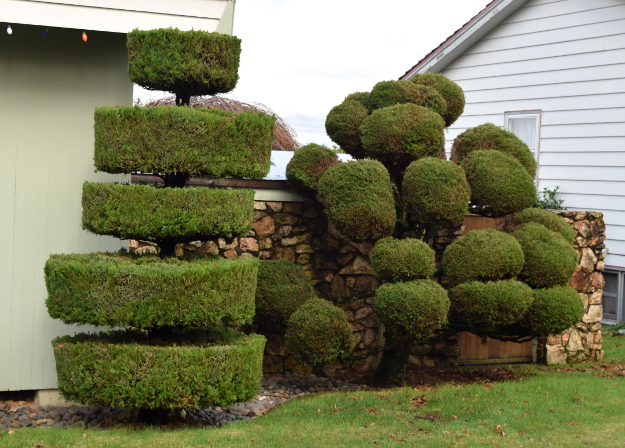
Before I realized that horticulture was my true calling, I was a sociology student with plans to become a professor of sociology. Then I discovered my love for plants. I left grad school after getting my master’s degree and took an entry level job at a nursery.

There haven’t been many times when my old world and new world have met, but I was thinking about the intersection of culture and horticulture this weekend when I explored a rather bizarre community near my home whose residents are obsessed with topiary.
I saw some weird and wonderful stuff, and the sociologist in me wanted to figure out why the people of Argay had chosen to create these Dr. Seussian landscapes.

Topiary is the ancient craft of shearing plants into certain shapes, like spheres, cubes, spirals, hedges, or hippopotamuses. Or giant slugs, as seen here. Bra pads? Computer mice? What do you see?
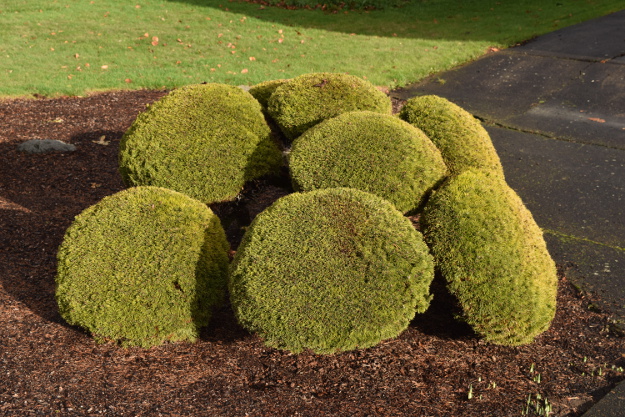
I loved these bar stool covers. I thought they were made out of goldthread chamaecyparis, but upon closer inspection, I realized that it was actually a severely sheared and chlorotic dwarf pine. I still think it’s fabulous.
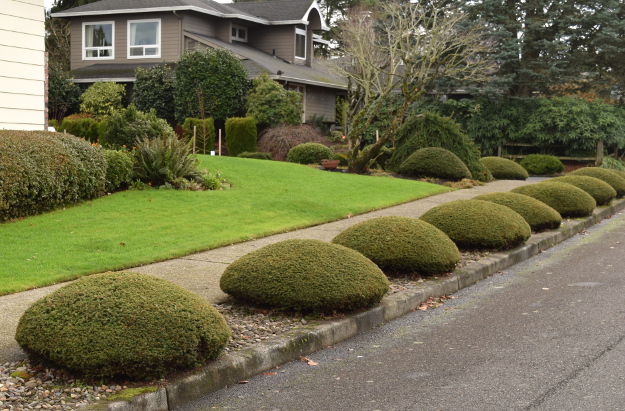
I also enjoyed these flying saucers made of spruce that had landed on this corner lot. Pillows? Muffin tops?
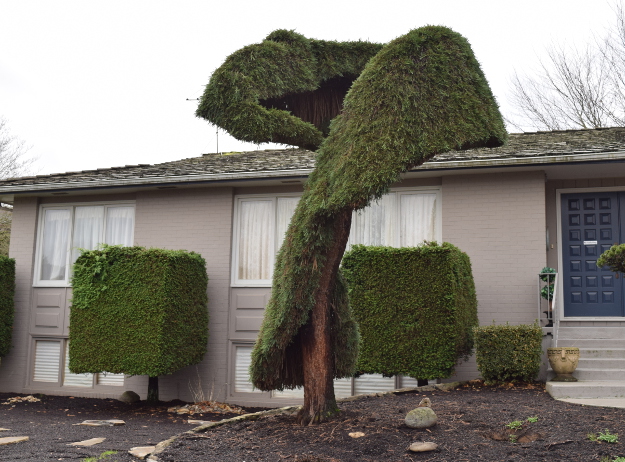
My favorite of all was a giant weeping sequoia green fur stole. Carpet remnant? This is the wackiest plant I’ve seen all year. Bravo! That is hilarious.
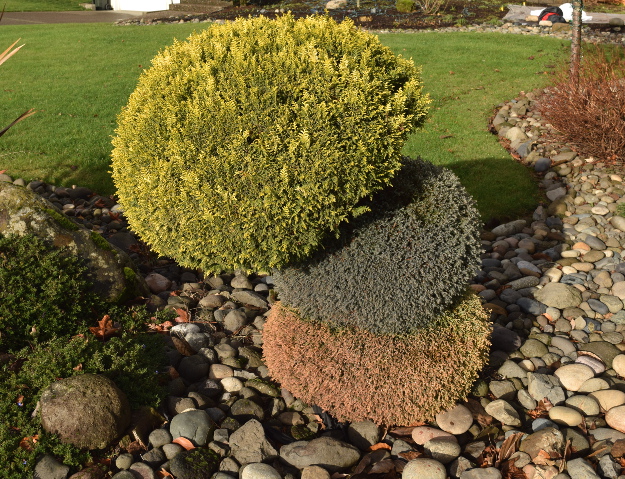
My second-favorite was this oddball. How about an orange ‘Rheingold’ arborvitae, a blue ‘Heather Bun’ chamaecyparis, and some sort of yellow chamaecyparis all grafted together? I’ve never seen anything like this, and I thought it was fascinating.

Argay is a quasi-suburb of Portland. Technically, it’s in Portland city limits, but it’s on the far northeastern fringes of the city, almost in Gresham. Argay is bounded by the Columbia River to the north, but I mostly stuck to the area south of Sandy Boulevard, north of I-84, and between 122nd and 148th Avenue.
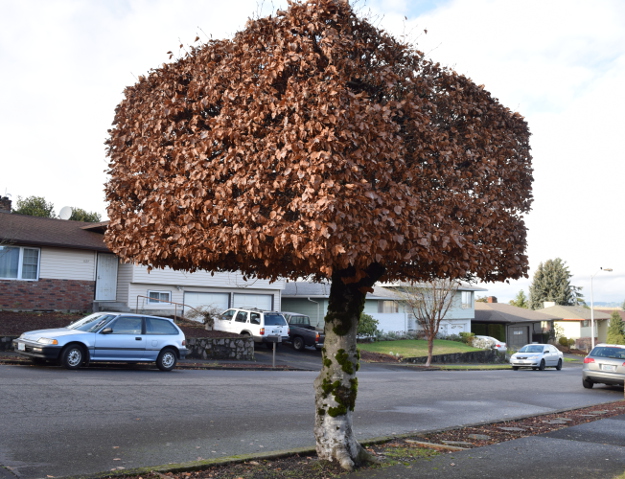
Trees are rarely allowed to take their natural size and form in Argay. This is one of four European beeches, an immense tree in the wild.
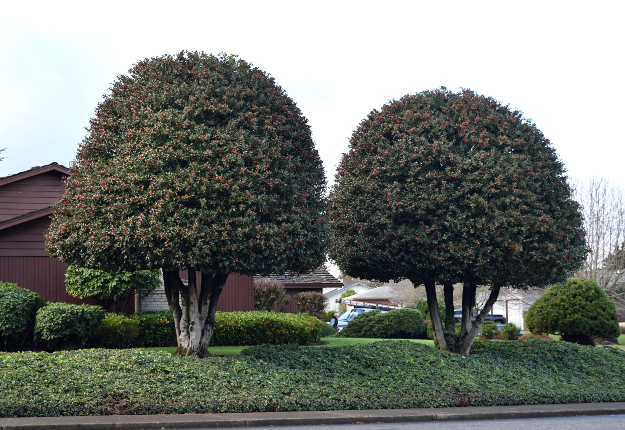
English hollies usually have a nice, dense, pyramidal form without any pruning at all; however, these two trees got the mushroom treatment. Gardeners here feel a need to call the shots.
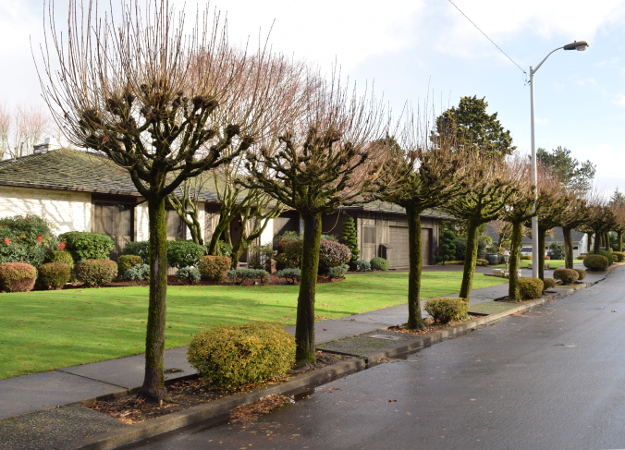
Many street trees in Argay are pollarded. Pollarding is an extreme pruning technique often practiced in European cities. When Americans try to pollard trees, we usually butcher them, but these maples look like they were pruned correctly. Still, it’s kind of a weird thing to do when there aren’t any power lines overhead.

Here’s one rare Japanese maple that escaped the pruners. Magnificent! Trees get very big here if you let them, and they grow fast.

Perhaps size control is one reason why topiary is so popular in Argay. Small trees, small problems; big trees, big problems when a bad storm comes through. And this area is in the direct line of fire from the fierce “East Winds” that sometimes rip through the Columbia River Gorge. No big limbs to fall from this stunted Japanese maple.
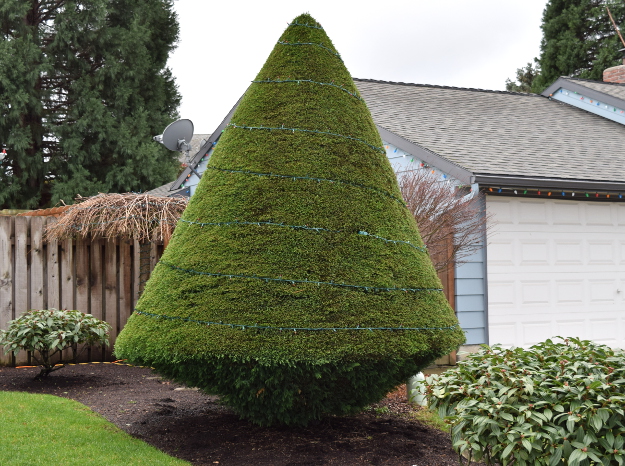
And this Leyland cypress will never fall on the house if it continues to be sheared like this.

A more sociological theory I have is that maybe topiary is used here as a status symbol. After all, isn’t that how lawns originated—as a way for the aristocracy to show off their wealth… to tell the world that they could afford to have land that wasn’t being used for anything but to look at?

Some of the properties here showcase quite a few intricately sculpted topiaries. No doubt they were expensive to buy and take a lot of time to maintain. Could this be a bit of horticultural boasting?
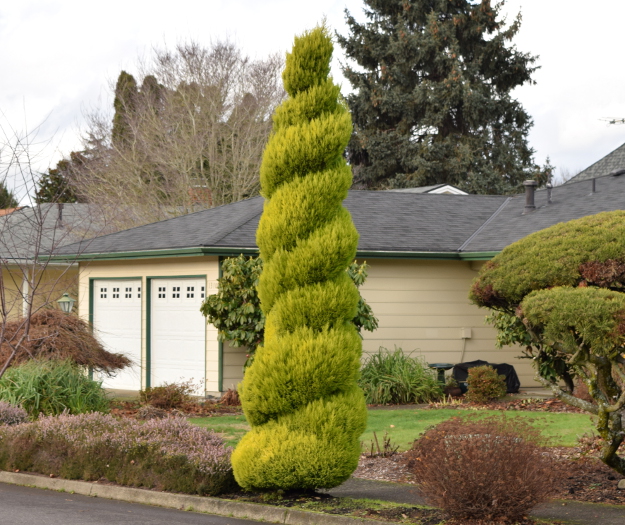
Or maybe topiary is a lot more common in the suburbs than I thought. Just part of the suburban aesthetic everywhere. The result of a perfect storm of relatively spacious yards, full sun, home ownership, disposable income, and a DIY/weekend warrior mindset.

So, do you see houses like this in the suburban areas in your part of the world? (OK, maybe this one goes a bit overboard and isn’t exactly representative.)
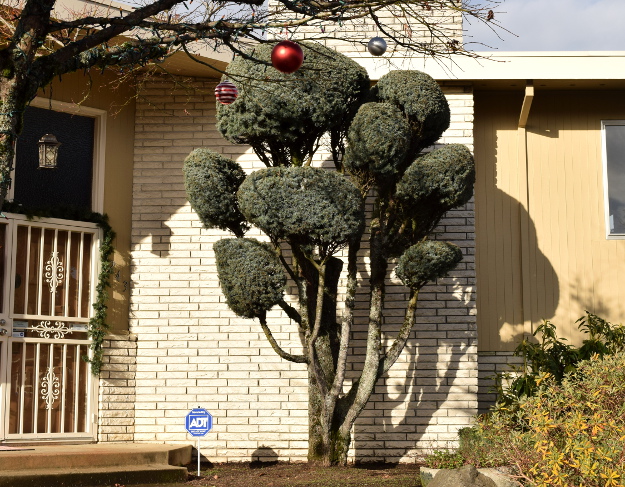
Maybe topiary is highly valued here as a means of artistic expression—a beautiful collaboration between man and tree. Who wouldn’t want this lovely blue spruce outside their door, perfectly set off by the white brick?
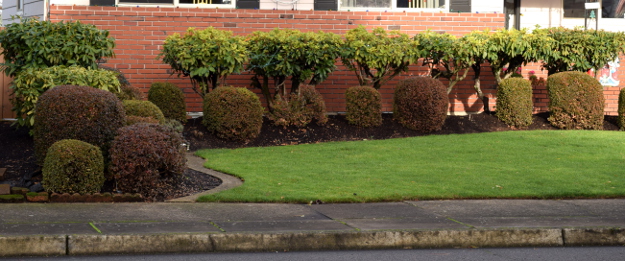
But I also saw a lot of landscapes like this one. Not exactly a work of art. Still, it adheres to the same basic aesthetic principles as nearly all the other landscapes in the neighborhood: Sheared plants. A wide-open front yard, no fence. A tidy lawn, neatly mowed and edged. No perennials—just shrubs and mulch. No weeds. No scraggly or errant growth of any kind. A very narrow plant palette of the most common exotic plants.
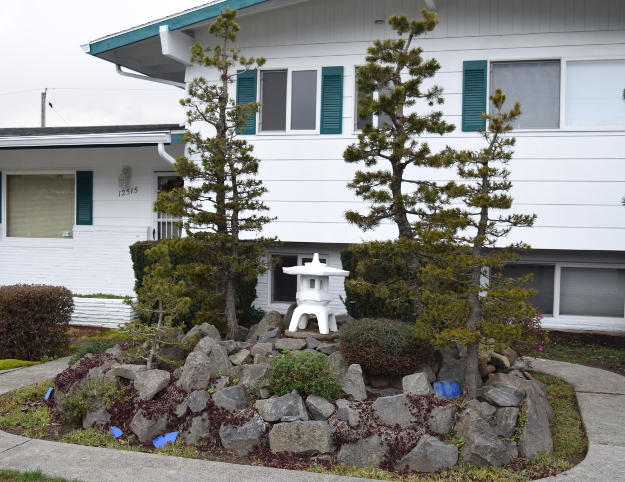
Then I saw this landscape. Minimalist but expertly executed. A strong point of view. Balanced, interesting, in harmony with the home and the climate. And it dawned on me—maybe this was the spirit that the rest of the neighborhood was trying to capture. An Asian aesthetic: clean, simple, a narrow plant palette, very few flowers, dwarfed trees, carefully manicured plants, topiary.
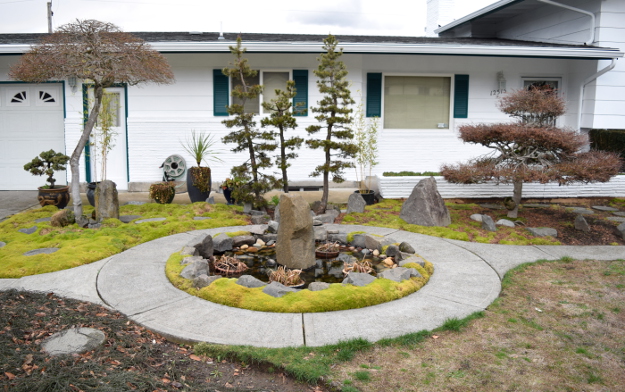
This is another section of the same landscape. Brilliant.
We have a handy online tool here in Portland called Portland Maps, which allows us to look up any address and find out who owns the property. I was curious about the style of this garden and looked it up to see if I could guess the ethnicity of the owners, and I found they had Vietnamese names.
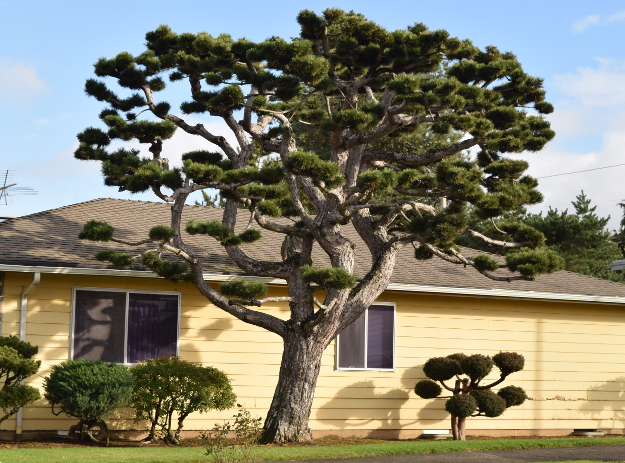
There are quite a few people of Asian descent in this area. Our branch of the library has a whole section of books in Vietnamese, and I think there is a Mandarin section as well. I thought if maybe Argay had a sizable number of Asians, that might help explain the great affection for topiary here.
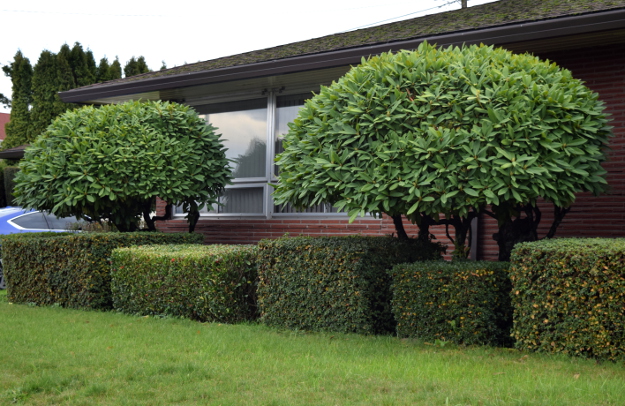
According to the latest census data, however, Asians make up 10% of the population of Argay, which is more than average for the country as a whole, but it’s not an overwhelming proportion. Hispanics make up 13%, blacks 13%, whites 60%, and mixed race/other 4%.

So maybe I don’t have it figured out after all. But I sure had a lot of fun exploring this neighborhood and writing this post!
And if I ever decide to go back to sociology, I think I know what my doctoral dissertation will be on.


Dear Amy, I have never imagined…. Wow! Thanks. Love, Mom
Thanks! Plants are pretty resilient, aren’t they?
A case of different strokes for different folks. When I see these, though they may be executed ‘well’, I see tortured plants and a gardener with a strong need to ‘control’ his/her environment (Okay…so, most gardeners have a bit of need to control. We are after all all part of ‘western’ civilization.) I get pollarding in formal design, just not my thing. Creativity valued more highly than the plant itself. Sorry. Some of the more ‘fanciful’ ones I like, but shrubs just cut into cubes??? Maybe if they are part of a larger composition.
I totally agree with you, Lance. I would never pollard a tree and I like to see trees being trees. I don’t understand the need for total control. It’s not my aesthetic, either, but it is interesting to see another point of view. Kind of like the Portland Japanese Garden. It’s very unlike how I want to garden (I need flowers!), but it’s fun to visit.
yikes. Indeed, the intersection of sociology or psychology and horticulture is an area ripe for exploration. You may be aware of the FB page Crimes Against Horticulture…. most of these would qualify.
People have very strong opinions on topiary, that’s for sure! I actually think some of these are very cool. Would they fit in my garden? No, but I enjoy seeing them. If my neighbor had that weeping sequoia I would get a chuckle out of it every day.
Interesting post, Amy. I try so hard to accept that some people like topiary, but I just can’t stand it. This summer I saw a whole landscape of ceanothus sheared into rigid geometric shapes, almost all of the blooms cut off, and literally gagged. I value natural forms above all, and prune to accentuate natural growth habits in my garden. I’m also lazy, so I see no point in things like topiary which need frequent and regular maintenance. However, much of my personal pruning aesthetics are based in an early introduction to bonsai, which, while typically seeking to represent an idealized tree in nature, are completely unnatural. So I do appreciate and even like the heavily-pruned conifers around the white house with the blue shutters. And that crazy pine tree is pretty amazing! The weeping sequoia is odd enough that I like it, too. It helps that that particular tree looks pretty unnatural regardless of what you do with it.
Ouch, sheared ceanothus makes no sense. I didn’t post a photo of a Chamaecyparis obtusa sheared into a cube in a hellstrip. It was heartbreaking. And a Japanese maple badly mangled into a cube-like shape. Maybe you should have to get a license to do topiary. The pine tree was really jaw-dropping though and I gotta say I love that silly weeping sequoia!
I too have wondered many times about the mindset behind certain kinds of gardening styles. As in WWTT??? I think it is very much a suburb thing – sometime you just have to do a double-take. That crazy weeping sequoia/stole is fantastic! I had some similar thoughts on the subject, if you’re interested. I for one, am looking forward to reading your dissertation! 🙂 https://flutterandhum.wordpress.com/2015/08/17/thoughts-on-domination-niwaki-and-the-topiary-arts/
Great article, Anna! I love the topiary sheep, and the molar analogy was spot on!
It’s fascinating to see how topiary has been embraced by this community. You don’t see as much of that in Austin, maybe because we don’t have as many hedge-able plants (conifers, etc.), although boxwoods often get that treatment, and even our native cenizos. It’s most often seen here in commercial landscaping, and I think that’s because a lot of the professional landscaping crews are from Mexico, where trees and shrubs in city parks are routinely sheared and pollarded.
It’s one thing for a homeowner who decides to topiary his or her plants for artistic reasons. But I find it sad to see plants sheared for “neatness” at businesses across town, for no other reason than the landscaping crew has always done it that way, and doesn’t know how to encourage a plant’s natural form.
We certainly have lots of good raw material for topiary… junipers, spruces, pines, and a ton of broadleaf evergreens. I didn’t post any photos, but the Japanese holly topiaries I saw were amazing. A lot of landscape crews, Mexican or otherwise, routinely make meatballs and boxes here, too. I think it’s just like you said, it’s the way they’ve always done it and it has no better reason than that. After seeing landscape after landscape done this way, it’s a relief to see a plant or two taking its natural form. On some of the topiaries, it was hard for me to even identify what the plant was.
Thanks for the abundant pics and thoughtful comments, Amy! Your insights on growth rate, wind & weather extremes provided helpful context.
I had wondered whether this was a Japanese community… Perhaps at one time the suburb included a larger number of folks for whom this aesthetic “felt like home”, and now the homes simply sell to folks of any ethnic background willing to take on the management demands?
There was a time when I rejected all notions of topiary and formal shearing, but recently have come to think some elements offer a way of introducing more cubic feet of greenery into concrete-dominated urban / suburban neighborhoods, gaining attendant infrastructure benefits.
For more fun, Google up “Niwaki” and check the images tab.
I’m also wondering if this was a predominantly Asian neighborhood in the past. If I ever decided to do a more thorough article, I’d look into that.
I’m generally not a fan of “meatball, meatball, cone” landscaping as I like to call it, but some of the more ambitious pieces are really cool. I wouldn’t mind having just one in my landscape, if it wouldn’t look too out of place.
Excellent post Amy! I love it when people/gardeners/homeowners have a vision and go for it, even if it’s not what I would do. So much better than the boring lawn with inherited foundation shrubs.
Thanks, Loree! I agree. There is something to learn from every style of gardening.
They are amazing, I am in Australia, how and where can I do a course on this?
I think you would have a hard time finding a topiary course. It is kind of a lost art, plus it is such a slow process – it wouldn’t work too well as a class. I think you would be better off searching for public or private gardens in your area with topiary and then approaching the gardener. He/She may be able to give you some helpful tips to get started, like which plants would be best to use in your climate. Then just practice, practice, practice!
That is a great tip particularly to those new to the blogosphere.
Brief but very precise info… Thanks for sharing this one.
A must read article!
I love variety & to see the creativity around me, both natural, & sculpted, floral & greenery, edible & not! I’m artistic & wish I had a bush, stamina, & fortitude to try topiary on part of a yard. Have you ever seen a topiary house? I’ve read about that in an English novel!